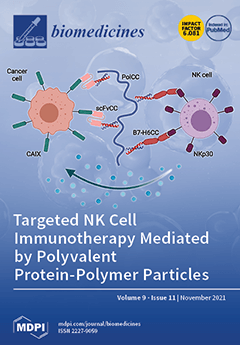Patients with Myalgic Encephalomyelitis/Chronic Fatigue Syndrome (ME/CFS) differ for triggers, mode of start, associated symptoms, evolution, and biochemical traits. Therefore, serious attempts are underway to partition them into subgroups useful for a personalized medicine approach to the disease. Here, we investigated clinical and
[...] Read more.
Patients with Myalgic Encephalomyelitis/Chronic Fatigue Syndrome (ME/CFS) differ for triggers, mode of start, associated symptoms, evolution, and biochemical traits. Therefore, serious attempts are underway to partition them into subgroups useful for a personalized medicine approach to the disease. Here, we investigated clinical and biochemical traits in 40 ME/CFS patients and 40 sex- and age-matched healthy controls. Particularly, we analyzed serum levels of some cytokines, Fatty Acid Binding Protein 2 (FAPB-2), tryptophan, and some of its metabolites via serotonin and kynurenine. ME/CFS patients were heterogeneous for genetic background, trigger, start mode, symptoms, and evolution. ME/CFS patients had higher levels of IL-17A (
p = 0.018), FABP-2 (
p = 0.002), and 3-hydroxykynurenine (
p = 0.037) and lower levels of kynurenine (
p = 0.012) and serotonin (
p = 0.045) than controls. Changes in kynurenine and 3-hydroxykynurenine were associated with increased kynurenic acid/kynurenine and 3-hydroxykynurenine/kynurenine ratios, indirect measures of kynurenine aminotransferases and kynurenine 3-monooxygenase enzymatic activities, respectively. No correlation was found among cytokines, FABP-2, and tryptophan metabolites, suggesting that inflammation, anomalies of the intestinal barrier, and changes of tryptophan metabolism may be independently associated with the pathogenesis of the disease. Interestingly, patients with the start of the disease after infection showed lower levels of kynurenine (
p = 0.034) than those not starting after an infection. Changes in tryptophan metabolites and increased IL-17A levels in ME/CFS could both be compatible with anomalies in the sphere of energy metabolism. Overall, clinical traits together with serum biomarkers related to inflammation, intestine function, and tryptophan metabolism deserve to be further considered for the development of personalized medicine strategies for ME/CFS.
Full article






